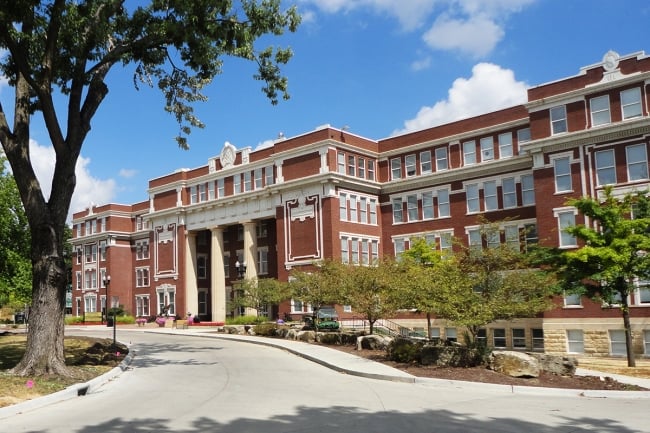You have /5 articles left.
Sign up for a free account or log in.

Emporia State University’s enrollment direction this fall was quite different from other Kansas public universities’.
On Sept. 27, the Kansas Board of Regents released encouraging news: overall enrollment in the state’s community colleges, universities and other public higher education institutions grew 2 percent from last fall, according to preliminary numbers.
The same day, the University of Kansas released triumphant news: it achieved its highest enrollment in 13 years and its largest-ever freshman class, which grew 18 percent from last year. Kansas State University, meanwhile, saw only 0.1 percent increase in its overall enrollment. But that was its first increase since 2014.
The Board of Regents’ data did show that three smaller public universities lost students. For two of these, the drops were modest: 2.2 percent fewer students at Pittsburg State and a less than 1 percent dip at Fort Hays State.
But then there was Emporia State University. Its enrollment plummeted 12.5 percent from last fall.
The raw number of lost students sounds even more ominous: 666. Emporia State now has 4,658 students, down 23 percent over the past decade.
Is Emporia State paying for its sins—sins, at least, in the eyes of tenure supporters?
About a year ago, Emporia State gained infamy among professors for abruptly informing 33 employees—30 of whom were faculty members, including 23 tenured professors—that they were losing their jobs. The fallout, and news coverage of that fallout, continues.
The American Association of University Professors publicly censured Emporia State’s administration, saying, “Unsatisfactory conditions of academic freedom and tenure have been found to prevail” at the university.
The AAUP has said that, under its recommended policies, universities can terminate tenured faculty members “under extraordinary circumstances because of a demonstrably bona fide financial exigency,” defined as “a severe financial crisis that fundamentally compromises the academic integrity of the institution” and can’t be solved in another way.
The association says faculty members should have input on whether a financial exigency exists, and that there should be due process, including a hearing before a faculty committee, for professors proposed to be laid off as a result. The AAUP stated in an investigative report that Emporia State didn’t declare financial exigency in this way and didn’t provide due process for those terminated.
From 2016 to 2020, Emporia State’s enrollment bobbed up and down between roughly 5,700 and 5,900. But enrollment dropped to 5,615 in 2021 and, last fall, it dropped to 5,324.
Officials cited enrollment declines and associated revenue drops for spurring the cuts in the first place. A dean said the university had previously chosen “to kick the can down the road,” forcing current leaders to act quickly to avoid many more possible layoffs.
But the 5 percent drop in enrollment between 2021 and 2022 more than doubled between 2022 and this fall, after the publicity around the cuts. The Kansas Reflector, which previously reported on the enrollment plunge, has covered the developments.
Ousted faculty members continue battling the university through the Kansas Office of Administrative Hearings and state court. Over the summer, 11 tenured professors who were terminated sued the university and the state Board of Regents in federal court.
Does any of this have to do with why Emporia State lost more than a tenth of its students in a single year? Gwen Larson, spokeswoman for the university, told Inside Higher Ed Monday she didn’t know whether university leaders had looked into that question.
“We actually don’t have any data about that particular supposition,” Larson said. “We understand why so much attention has been focused on the actions we took last fall but, over all, we are trying to rightsize Emporia State University for the future.”
But in a follow-up email Tuesday afternoon, Larson wrote, “Certainly, the changes we made last fall have impacted enrollment. We have completely changed our academic structure, we canceled some programs, we added some programs. We are in the middle of a transformation and are rebuilding our entire institution. Change takes time. We expected enrollment to be down.”
She wrote that the university expected an enrollment drop of 10 to 14 percent and “anticipates an additional single-digit drop in fall 2024 and stabilization in fall 2025.”
Kim Simons, a biochemistry and chemistry professor who is Emporia State’s Faculty Senate president, said, “I don’t think an analysis has been done, so we don’t know for certain” whether the cuts and controversies might have changed prospective students’ minds about coming to the institution. He noted that it’s hard to ask students who didn’t enroll why they didn’t, but he thinks the faculty and academic program cuts are “reasonable possibilities.”
A Board of Regents spokesman didn’t return requests for comment this week on why Emporia State’s recent enrollment diverged so much from other institutions’.
Larson proffered that the drop in Emporia State’s graduate students—who accounted for about half of the 666-student drop, and who represent about half the university’s overall enrollment—could be due to lower demand among students for online career advancement programs amid a labor shortage in an improved economy.
“We’re investing in what we believe, from analysis, will be growing career paths, plus what our students are telling us they want based on what they are enrolling in,” she said.
Unavoidable Decline?
While Emporia State made headlines for the way it ignored tenure in slashing faculty jobs, it’s certainly not the only regional public university in the past decade to jettison tenured faculty members in making significant position and program cuts.
Universities often put a positive spin on cuts, saying they’re about investing in growing programs rather than settling for a smaller institution. So how have other universities fared since axing employees and degree offerings? Anecdotes point in different directions.
In 2015, the AAUP censured the University of Southern Maine after it eliminated four academic programs and more than 50 tenured and nontenured faculty positions, all without declaring financial exigency. (On Wednesday, the university said it actually cut six programs in 2015.) The previous year, the university had backed off some proposed cuts after national blowback, but then it charged ahead and proceeded to cut between one-fifth and one-sixth of its full-time faculty.
Southern Maine’s enrollment has continued declining, from more than 10,000 in 2014–15 to 7,915 last fall.
But enrollment has also dropped at institutions that backed off from big cuts. Unlike Southern Maine, the University of Wisconsin at Stevens Point abandoned its controversial 2018 plan to end 13 majors and possibly lay off tenured faculty—the chancellor at the time said other budget reductions, along with resignations and retirements, eliminated the need for layoffs.
Nevertheless, UW Stevens Point’s enrollment continued to slide. Around the time of the controversy, its numbers shot up from 8,208 in fall 2017 to 9,107 in fall 2018 (two colleges merged into it in 2018) but then plummeted the next fall to 8,325. Enrollment continued shrinking through fall 2022, when UW Stevens Point had about 8,000 students. A University of Wisconsin spokesman said Stevens Point’s “estimated preliminary enrollment” for this fall, based on first-day enrollment figures, is 8,256.
Western Illinois University, by contrast, has had a long history of cuts, drawing media coverage and protest rallies. In December 2015, officials said they planned to cut 50 faculty positions. In June 2016, its Board of Governors approved cutting four degree programs. Enrollment dropped from 11,094 in fall 2015 to 10,373 in fall 2016 and continued plummeting.
By fall 2019, Western Illinois had 7,624 students. In spring 2019, the university announced more than 130 employee layoffs, including 29 faculty members, citing financial challenges from enrollment loss and other issues. Enrollment fell a little for the next two years but then recovered in 2022 to 7,643, the latest year for which data are available.
Donald A. Resnick, a global higher education consultant who previously served as the New School’s chief enrollment officer, among other roles, said press coverage could contribute to a loss of confidence in an institution among students, family members, guidance counselors and others who influence enrollment choices. And with upset university employees “in relatively small locales” where “people know each other, you’re going to have this general tentacle-ing of an understanding of an environment of discontent,” he said.
However, Resnick said that, unless institutions survey students who were admitted but didn’t enroll as to why they chose not to, “it’s incredibly hard to prove cause and effect.”
“Every individual circumstance needs to be looked at just that way: individually,” Resnick said. “Many times, institutions don’t do enough research into the whys.”
So why the drop at Emporia State?
“I wish we were better about creating tools to be able to track data like that, instead of just grasping at straws,” said Mallory Bishop, vice president of Emporia State’s Faculty Senate. She said students may feel general negative “vibes” about the university, yet they may not be following traditional media enough to know the degree of the university’s “turmoil.”
Robert Zemsky, a University of Pennsylvania professor who studies higher education, said he doesn’t know much about Kansas. He spoke to bigger trends.
“There’s a general devaluing of higher education except at the very top of the market,” Zemsky said. “The big are getting bigger, and the rich are getting richer, and everybody else is in trouble.”
The 25,470-student University of Kansas—a member of the prestigious Association of American Universities research institution group—sure seems to be doing better this fall than Emporia State. But the University of Kansas has also been mulling program cuts in recent years.
And there is a flagship in another state that’s recently made headlines for slashing faculty positions and degree offerings: West Virginia University.
Will those cuts and the public attention mean an even bigger enrollment decline next fall for WVU, which has been seeing drops every year for a decade? WVU, echoing the other institutions that have made cuts, has said it wants to invest in growing programs after cutting low-enrollment ones.
Rose Casey, an assistant professor in WVU’s English department, raised concern at a Monday Faculty Senate meeting that “every single [employee] I know is on the market. I’ve literally never encountered that before here.”
“And, in addition, every Ph.D. student I know is applying for other Ph.D. programs, because people are terrified about staying because of the long-term consequences of the instability we’re going through right now,” Casey said, “and the absolutely massive reputational damage that has been caused by the extent of these cuts and the way they’ve been carried out.”
Bishop said she thinks there’s a lot of value in figuring out why enrollment dropped at Emporia State, both for the university itself and for others who might see its cuts as a “model.” Everyone on campus lost something, she said, including leadership.
“It just really, fundamentally, hurt people,” she said, “and I think we need to put more attention there as well.”

f24e.jpg)

